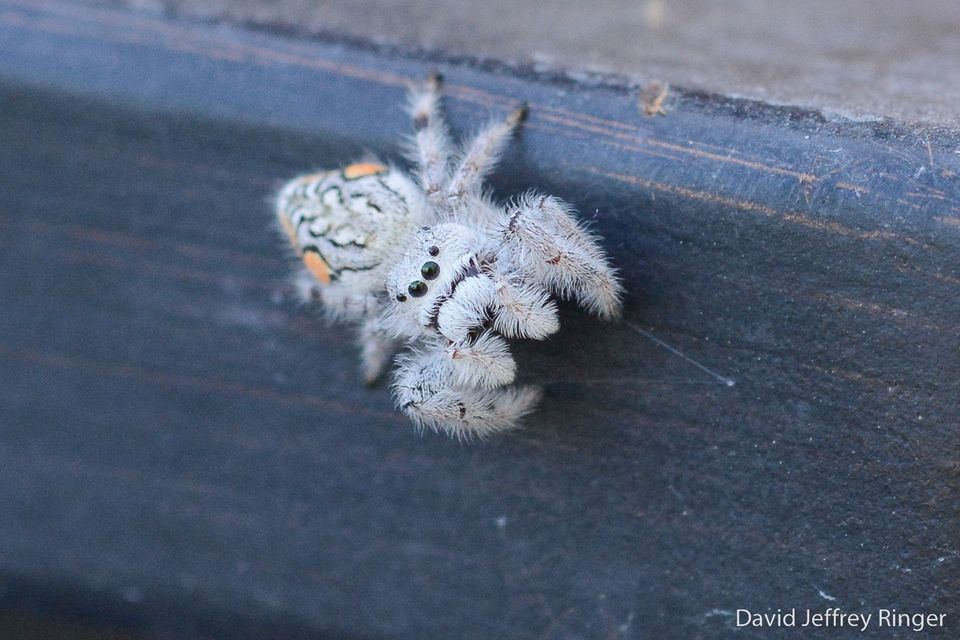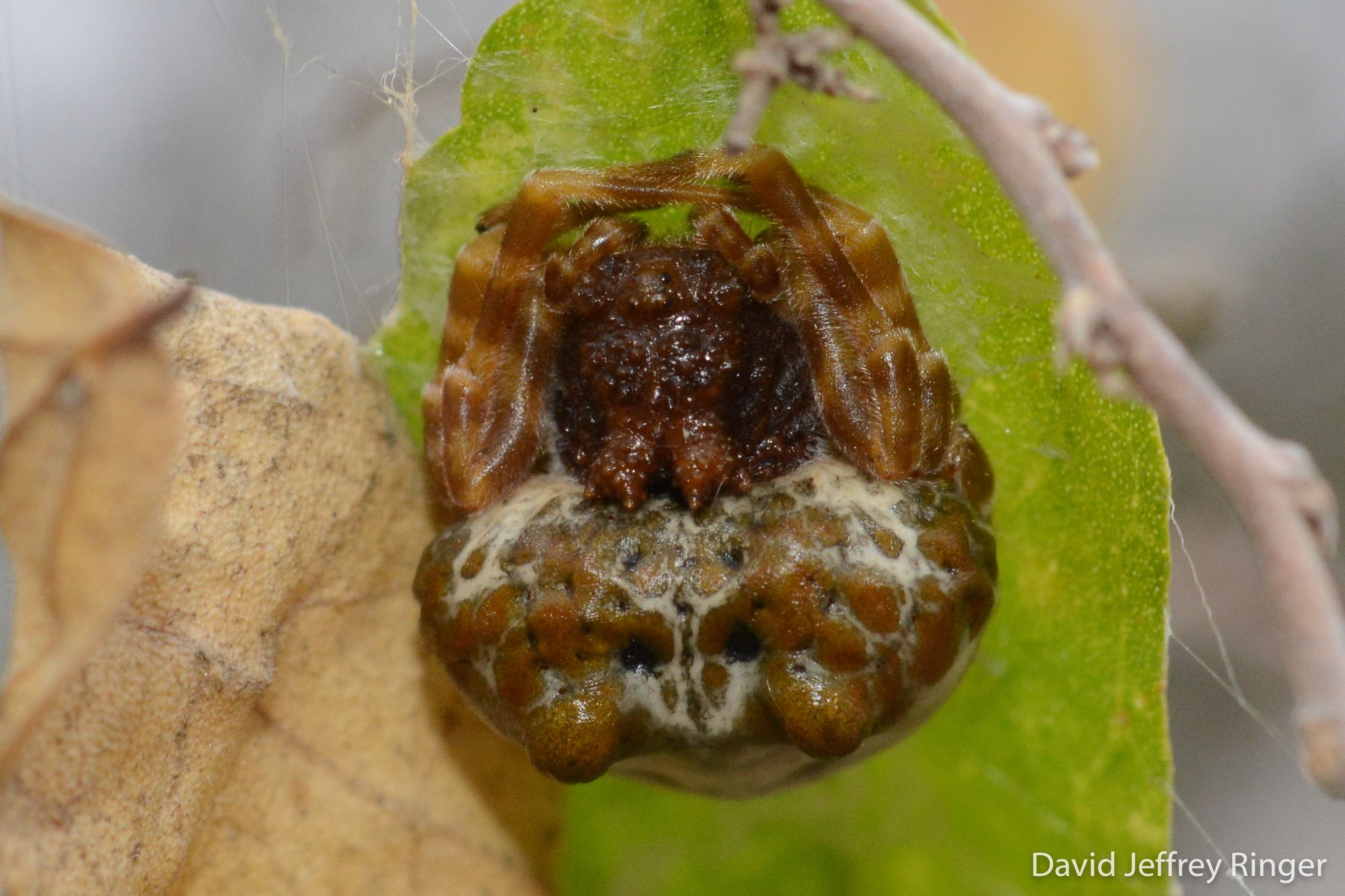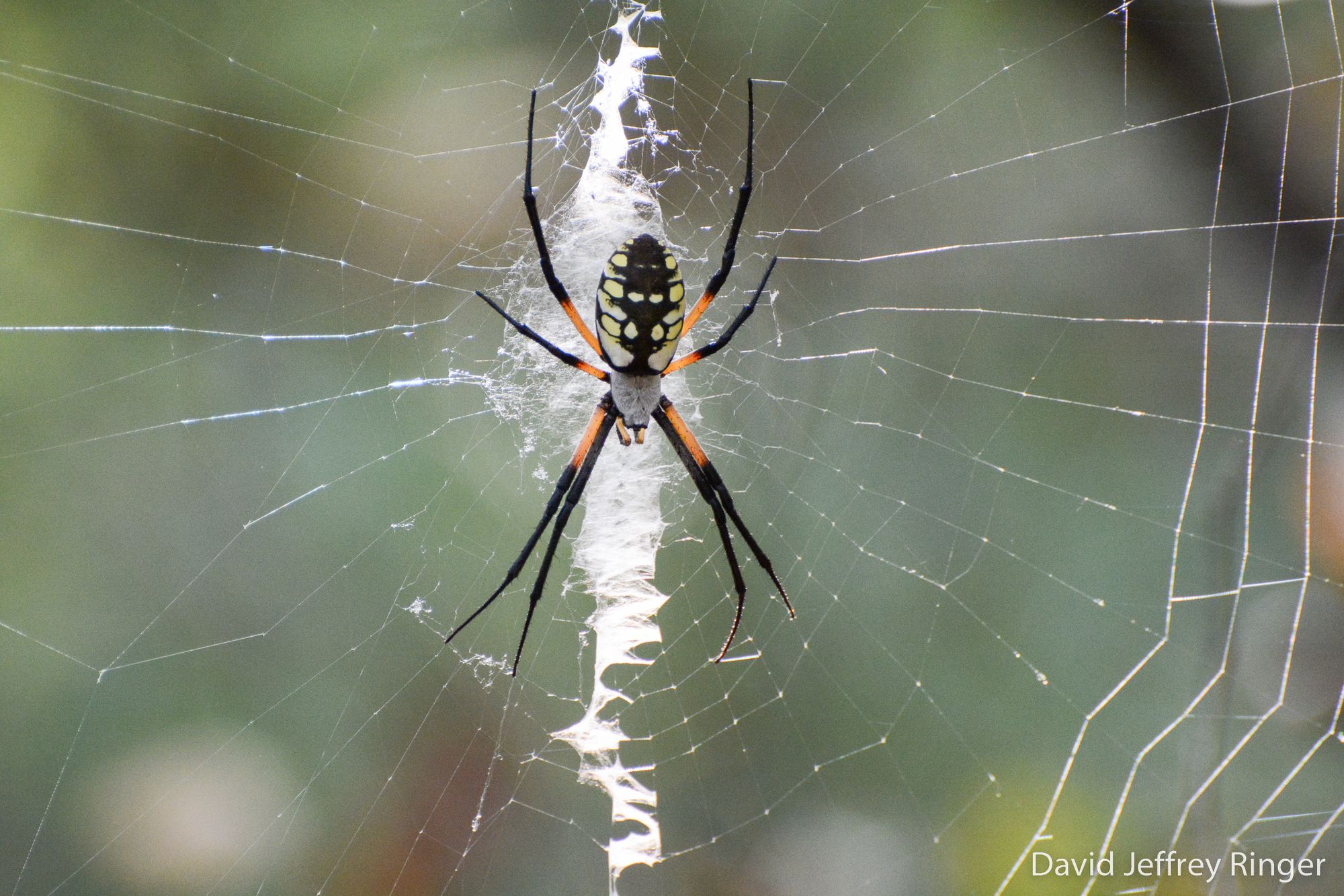On Spider Biodiversity, My Arachnophobia, and Our Place in the Universe

Paraphidippus fartilis is a large, tree-dwelling jumping spider that in the United States lives in a single county: Cameron County, Texas, where the Rio Grande meets the Gulf of Mexico and where I spent the winter of 2020-21. P. fartilis, despite its beauty and charms, has no English name, which is truly a shame and only goes to show the limits of a language even as lusty and opportunistic as English, which has spent more than a thousand years gobbling up morphemes and lexemes, first from all over Europe and then the world, and piling them onto its Old Germanic back like a lacewing larva building a shell from contorted husks of its gastronomic victims.
But P. fartilis. The adult female is cloaked in a coat of long and dense white hair and decorated on her dorsal abdomen with variable strokes of safety orange and black that grades into metallic green. Her eight eyes gleam like polished orbs of obsidian—eight eyes that give her a 360-degree field of view, with specializations among them that let her detect motion and changes in light, and in the case of those two big forward-facing anterior median eyes, give her not only true depth perception but also tetrachromatic vision that lets her see the world by reflected red, green, blue, and ultraviolet light, a richer and more complex visual experience with color and space than we poor two-eyed, trichromatic primates can even properly imagine.
I saw her first from my balcony as she explored the limbs of a silk floss tree, maybe 20 feet above the ground, gleaming white in the morning sun and, with her fluffy legs considered, spanning nearly an inch in length. Impressive. Intriguing, even for a person with lifelong arachnophobic tendencies.
Yes, an almost crippling fear of spiders. I don’t have a good reason for it. No traumatic memory, no painful bite or sudden shock. Just a simmering unease that might flare into panic in the garage, in the basement, in the garden, in front of a screen.
I spent my childhood bringing cicada skins and tadpoles into the house and raising interesting caterpillars into glorious monarchs, swallowtails, and cecropia moths. I grew mealworms in the garage to feed a toad and caught grasshoppers for one summer’s praying mantis pet. I got bitten by snakes and turtles and stung by many wasps and bees. Why should anything be different about spiders? But something was. Something still is.
Next thing I knew, P. fartilis gripped a shiny green latrine fly in her powerful jaws, an unfortunate if apt name for the fly, adding insult to mortal injury in this case. She maneuvered its body across the surface of a papaya-shaped seedpod on the tree, annoyed by a reddish carpenter ant that was tugging at a leg of the fly. The fly was dead, the struggle already over. I’d missed the strike, powered by the jumper’s vision and lethal spring.
“Eight-legged cats” is a jumping-spider nickname featured in the title of a year-2000 scientific paper on these charismatic arachnids’ hunting abilities and visual acuity. Among other things, “Eight-Legged Cats” reports on the extraordinary capabilities of an Eastern Hemisphere jumping spider genus called Portia, whose members can plan, deceive, and problem-solve while hunting other spiders, “cognitive attributes more often associated with large predatory mammals such as lions and rarely considered in studies on spiders,” the authors wrote.
Good thing we have the upper hand in size.
If you’ve ever leaned over to look more closely at a jumping spider, you’ve probably seen it turn itself to look back at you. Eye to eye, dead on. It’s an extraordinary moment, you looking into all those eyes, and it looking into your two. You’re not imagining it. The spider’s anterior lateral eyes alerted it to your approach, and now it’s turning its color- and depth-sensing anterior median eyes to look at you. Are you a threat? Are you something else?
What does it see when it looks at your face? If the jumping spider weighs 100 milligrams and you weigh 165 pounds, you are almost 750,000 times its size, more than twice the mass gap between the Earth and the sun. We’ll never be able to answer the question of what exactly the jumping spider sees to our satisfaction, because when we ask that question, we’re really asking what meaning it draws from its visual stimulation. Does it recognize you as a sentient, living animal? Does it recognize your eyes as eyes, the way bearded dragon lizards may possibly recognize human hands as analogs to their own forelimbs? We do not know.
We do, however, know this: That jumper does see you, and with a calculating clarity and intelligence that require quite a bit of humility to consider, not to mention courage.
None of this is to say that I’ve conquered my bone-deep discomfort with spiders.
No, there was the Texas afternoon that I saw a huge huntsman spider—Heteropoda venatoria—running with heart-pounding speed along my foundation, then flattening out its 3-inch legspan, or the morning a storm blew open an outside door, revealing a crouching 2-inch crevice weaver called Kukulcania after the Mayan serpent god.
Every time, my nervous system still screams, “Fight or flight! Flight!” I feel it in my gut, my throat, my limbs.
The thing is, I get to choose what happens next.
If I will myself stay, or even get a little closer and really take in that eight-legged wonder before me, I become an explorer on the edge of the universe, staring down danger because knowing is worth it. Risking it all to bear witness. There’s a joke here, of course. I’m not exactly an astronaut stepping out into the void, not quite a spelunker squeezing through a narrow crack far below the surface. We’re talking about leaning forward to peer at a spider on a wall, a web, a leaf.
But in any context, one of the most human things we can do is to push past terror, rational or otherwise, to the exhilaration that breaks as you suddenly see farther than you knew was possible—while your stomach still scrabbles on that little door at the back of your throat.
South Texas is loaded with spiders, a consequence of its humid subtropical climate, which produces abundant year-round food in the form of insects and other small invertebrates (and, occasionally, vertebrates) for a dizzying diversity and biomass of spiders.
The tropical Eriophora orb-weavers string enormous sticky webs between mesquite trees in the brush, fat and hairy goblins in the night. Discreet meshweavers create tiny netted shelters in the crook of a single acacia twig. Bolas spiders make chemicals that male moths mistake for female sex pheromones, luring them in close enough to be snagged on a swinging silk snare. Ouch.
Spiders lumber along the ground and float through the air on electrostatically charged silk and lurk in tunnels and patrol the lichen-blotched bark of the generous hackberry trees, sometimes mimicking ants.

They cluster around our homes and buildings—some of them only here because of us, synanthropes, vagabonds that have followed humans around the world, eating our cockroaches and fruit flies indoors and the moths and mayflies that come to our porch lights, driven temporarily mad by those strange beacons that call into their darkness—whoops, there you are in the web, and that’s the end.
Spider silk is one of the greatest bioengineering triumphs in planetary history. To begin with, it’s not just one material but many, each with a distinct set of properties and functions, like cementing, entrapment, support, protection, and so on. Each type of silk is produced by a different gland in the spider’s body—up to seven varieties of glands in orb-weavers. As silk exits the spider’s abdomen, the spider can manipulate it further, combing it to make it rough or knitting it into loops.
Spider silk can contain complex molecules like lipids and pigments, but it is primarily made of elaborate protein fibers, assembled from amino acids like glycine and alanine. In our own bodies, glycine plays a critical role in forming the triple-helix structure of the the protein collagen in our skin, our bones, our tendons, and our muscles; it is also a neurotransmitter. Alanine is important in our metabolisms and immune systems, and it is a source of energy for our hardworking brain cells.
These amino acids are made up of hydrogen, carbon, nitrogen, and oxygen atoms, those last three with the atomic numbers 6, 7, and 8 for the number of protons in their respective nuclei. Those nuclei formed in violent reactions within huge stars and were blasted out into the void when the star exploded to wander, drift, and settle, reincarnated someday into a glycine molecule inside a protein strand bound into a marvelous thread of spider silk, or if history turns out just a little bit differently, a collagen fibril in the cornea of my own eye.

Carl Sagan, with great beauty and clarity, seared into our consciousness the idea that we are made of star stuff, but of course it is not just we; it is the spiders too, and they in turn are capable of spinning stardust into remarkably strong and versatile materials. Spider silk’s toughness—that is, how much energy it can absorb without breaking—can be more than three times that of Kevlar, the synthetic polymer used to stop bullets.
We human beings talk a good game about meeting alien life someday—what it might be like, how we might react, how it might react to us. Well, we might have grown up on the same planet as the spiders, but we’re separated by something like 700 million years of deep time.
If, in an effort to understand that enormous number, we try to visualize that sea of time as distance, we can turn our eyes toward the night sky. We know that the light of the stars and other celestial objects takes time, traveling at 186,000 miles per second, to reach our retinas after leaving its source. The light reflected from the moon reaches Earth in just over one second; from Saturn in six minutes. The light of the farthest stars that are still visible to our naked eyes has traveled a paltry few thousand years. The light from the farthest object we can see unaided—the trillion-odd stars grouped in the galaxy Andromeda—has been traveling 2.5 million years to reach us, impossibly long to our own sensibilities but a blink of a cosmic eye.
Galaxies clump together in space; our Milky Way and neighboring Andromeda are two galaxies out on the far edge of a galactic supercluster more than 100,000 galaxies strong. Human scientists call our home supercluster Laniakea, which means immense or immeasurable heaven in the Hawaiian language.
Light takes about 500 million years to travel the ineffable expanse of Laniakea, and if it travels another 200 million years beyond that, then finally, we arrive at the point of distance between ourselves and the spiders, a gulf beyond comprehension.
And yet. And yet. You’re no more than a few yards away from a spider at this very moment. Maybe it’s a wispy cellar spider hanging belly-up in the corner of your ceiling, in a web she has forged out of long-dead stars, so very nearly incorporeal that you might have to stand on a chair to see her at all. But she is there. And so are you.